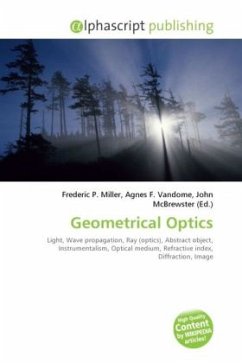
Aperture
Versandkostenfrei!
Versandfertig in 6-10 Tagen
32,99 €
inkl. MwSt.

PAYBACK Punkte
16 °P sammeln!
In optics, an aperture is a hole or an opening through which light travels. More specifically, the aperture of an optical system is the opening that determines the cone angle of a bundle of rays that come to a focus in the image plane. The aperture determines how collimated the admitted rays are, which is of great importance for the appearance at the image plane. If the admitted rays also pass through a lens, highly collimated rays (narrow aperture) will result in sharpness at the image plane, while uncollimated rays (wide aperture) will result in sharpness for rays with the right focal length...
In optics, an aperture is a hole or an opening through which light travels. More specifically, the aperture of an optical system is the opening that determines the cone angle of a bundle of rays that come to a focus in the image plane. The aperture determines how collimated the admitted rays are, which is of great importance for the appearance at the image plane. If the admitted rays also pass through a lens, highly collimated rays (narrow aperture) will result in sharpness at the image plane, while uncollimated rays (wide aperture) will result in sharpness for rays with the right focal length only. This means that a wide aperture results in an image that is sharp around what the lens is focusing on and blurred otherwise. The aperture also determines how many of the incoming rays are actually admitted and thus how much light reaches the image plane (the narrower the aperture, the darker the image). An optical system typically has many openings, or structures that limit the ray bundles (ray bundles are also known as pencils of light).












